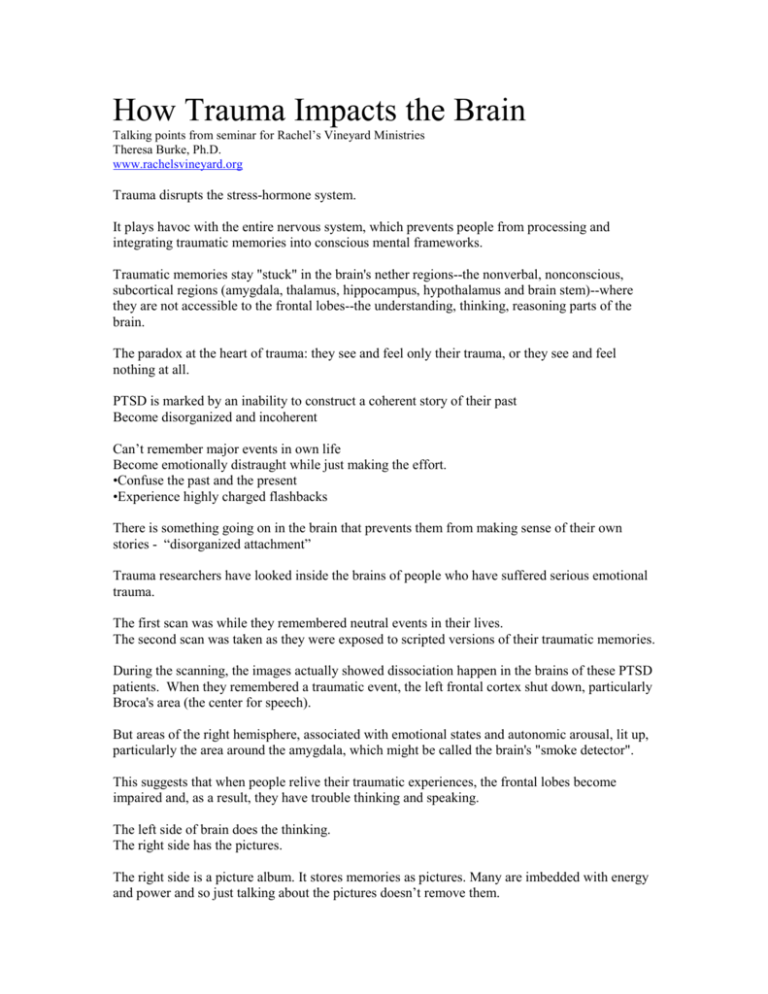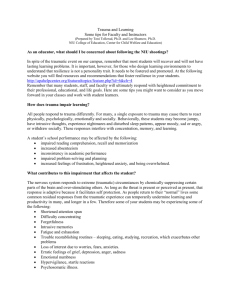How Trauma Impacts the Brain
advertisement

How Trauma Impacts the Brain Talking points from seminar for Rachel’s Vineyard Ministries Theresa Burke, Ph.D. www.rachelsvineyard.org Trauma disrupts the stress-hormone system. It plays havoc with the entire nervous system, which prevents people from processing and integrating traumatic memories into conscious mental frameworks. Traumatic memories stay "stuck" in the brain's nether regions--the nonverbal, nonconscious, subcortical regions (amygdala, thalamus, hippocampus, hypothalamus and brain stem)--where they are not accessible to the frontal lobes--the understanding, thinking, reasoning parts of the brain. The paradox at the heart of trauma: they see and feel only their trauma, or they see and feel nothing at all. PTSD is marked by an inability to construct a coherent story of their past Become disorganized and incoherent Can’t remember major events in own life Become emotionally distraught while just making the effort. •Confuse the past and the present •Experience highly charged flashbacks There is something going on in the brain that prevents them from making sense of their own stories - “disorganized attachment” Trauma researchers have looked inside the brains of people who have suffered serious emotional trauma. The first scan was while they remembered neutral events in their lives. The second scan was taken as they were exposed to scripted versions of their traumatic memories. During the scanning, the images actually showed dissociation happen in the brains of these PTSD patients. When they remembered a traumatic event, the left frontal cortex shut down, particularly Broca's area (the center for speech). But areas of the right hemisphere, associated with emotional states and autonomic arousal, lit up, particularly the area around the amygdala, which might be called the brain's "smoke detector". This suggests that when people relive their traumatic experiences, the frontal lobes become impaired and, as a result, they have trouble thinking and speaking. The left side of brain does the thinking. The right side has the pictures. The right side is a picture album. It stores memories as pictures. Many are imbedded with energy and power and so just talking about the pictures doesn’t remove them. The language here is not words but a picture. This is where Post Traumatic Stress Disorder (PTSD) pictures come from. And traumatic memory is like a series of still snapshots or a silent movie. There is no music or words. Coherent narratives about the past require both left and right hemispheres to be fully online The right side holds the images, themes and sense of personal existing across time, while the left holds the drive to make logical meaning and put words to wordless feeling states and perceptions. This explains the difficulties people have in creating a coherent narrative: if the two sides of the brain are not working together, the story will be either chaotic and confused--overwhelming feeling, overwhelmed thought--or superficially logical but lacking the emotional oomph of a good coherent autobiographical story. There is a connector between the two sides, the corpus callosum. This is how the two sides of the brain communicate. The corpus callosum is the bundle of nerves that connects the two sides and integrates the emotional and cognitive aspects of our existence. We need the functions of both sides to have balance and derive the most out of life. Hypothalamus--receives incoming information through our senses: sight, smell, hearing, touch and taste, then passes it on to other parts of the brain for processing. Hippocampus involves memory and encoding new information. Past experiences & facts Feelings Thoughts Awareness of our autobiographical past Hippocampus controls our emotional response by transforming sensory stimuli into emotional and hormonal signals then refers this information to other parts that control behavior. Frontal Cortex--acts as supervisory system of the whole process of integration of emotional and cognitive functions. When the brain functions the way it’s supposed to we function well. Trauma can change all that. Trauma is a wounding. It overwhelms the ordinary adaptations to life. Trauma can create PTSD. This is not just an emotional response to troubling events; it’s the expression of a persistent deregulation of body and brain chemistry. Brain is assaulted by neurotransmitters -- brain chemistry can be altered for decades. With this change, arousing events can trigger flashbacks. Trauma creates chaos in our brain. The amygdala is a small, almond-shaped portion of the brain. It’s the emotional part. It’s the primitive part of the brain. It interprets messages that there’s danger or it’s safe. It knows nothing about reasoning or cognitive functions. It deals with feelings and emotions. It controls emotional reactions such as fear & anger. (Amygdala) It’s the alarm portion of the brain. It becomes highly active during and while remembering a traumatic incident. It controls our behavior. When you’ve been in trauma it’s hypersensitive--overreacts to normal stimuli. Trauma freezes thinking. It’s as though the left side (the cognitive) and the right side (the emotional) are disconnected from one another. Usually our body and emotions and thoughts are all connected. Trauma separates these from one another. You may have vivid graphic thoughts about what happened but no emotion. Or you could experience intense emotions but without the thoughts or actual memories. Sometimes you alternate between the two. You find yourself caught between amnesia or reliving the trauma, between floods of intense, overwhelming feeling or blank numb states--no feeling. Constant battle: between irritable, impulsive action OR complete inhibition of action--complete paralysis. Dissociation is a separation of the elements of the traumatic experience, which REDUCES the impact of the experience. Floating above body Traumatized people are used to dissociation, not feeling their bodies; the memories cause them to shut themselves down, go numb, blank and frozen in order not to feel anything. Trauma can be intrusive. It can interpret and dictate your current life. Traumatized people have alterations in their brain. Memory is affected by lapses--there are deficits in verbal recall. The frontal cortex ability is decreased. Less ability to do left-brain functions--it can’t distinguish a real threat from a false threat. Intense stress or trauma is accompanied by the release of hormones. A nerve running out of the brain to the adrenal glands triggers adrenaline and noradrenaline secretions. Adrenaline and noradrenaline surge through the blood stream causing the heart to beat faster and prime the body for an emergency. Then these hormones activate receptors on the vagus nerve running back to the brain. This causes the heart to continue to beat faster, but also signals various parts of the brain to supercharge that intense emotional memory. These hormones assist the individual to mobilize in the event of emergency. They also sweep through the body, return to the brain, and trigger the release of more equally powerful hormones (cortisol, epinephrine and norepinephrine, oxytocin, vasopressin and opioids). This flood of hormones produces the "fight-flight" response in most people. When a trauma hits up to 70% of your brain-bound oxygen is diverted into your muscles to propel you somewhere else. But for a few individuals, it produces a "freeze" mode. In this instance, all those hormones are rushing through the body and have no appropriate physical response. The stress has paralyzed the victim. Therapy should stimulate right hemisphere of brain Guided imagery Sensate body focusing Practice in using and picking up non-verbal cues Pre-Frontal Cortex integrates It allows brain circuits to fire Gives people a sensation of inner awareness that they may not have had before Brings about neural changes--“integration” “coherence” “self-regulation” Self-regulation is the balanced and integrated flow of energy and information through the major systems of the brain-brain stem, limbic circuits, anatomic nervous system Mind, Brain, Body Equilibrium = Secure, stable state We can face life with emotional calm; Flexibility; Self-awareness; Reason Since trauma is situated in these sub-cortical areas of the brain, we need to do things that change the way people regulate these core functions-- which cannot be done by words or language alone. Andrew Newberg – U of P Prayer and meditation stimulate frontal cortex Using new scanning techniques, neuroscientists have discovered that certain areas of the brain light up which indicate positive emotions and good mood in Buddhists and cloistered nuns in a state of prayer. There is brain activity in the left prefrontal lobes. The area is linked to positive emotions, self-control and temperament. Other research suggests that meditation and mindfulness can tame the amygdala, an area of the brain which is the hub of fear memory. There is a whole science of somatic memories – “The Body Remembers” The work of healing is really about re-arranging your relationship to your physical and spiritual self. If you want to work with a traumatized person, you have to work with core physiological and spiritual states, and then the mind will start changing. The treatment should help people not become so aroused that they shut down physiologically, so they'll be able to process the trauma themselves. The treatment must help people regulate their affective states. (Calming, breathing, soothing) so a person can find the strength to face her own inner horrors and begin to move on and regain life for herself. Humans are programmed by evolution to flee, fight or freeze in the face of grave threats to life and limb. When these natural responses to danger are thwarted and people are helpless to prevent their own rape, or beating, or car accident, or abortions, the unfinished defensive actions become blocked as undischarged energy in the nervous system. They remain frozen in an “unfinished” state of high biological readiness to react to the traumatic event, even long after the event has passed. Psychological trauma is very much about an action that was interrupted. You need to complete the trauma. Profoundly healing interpersonal experience means Focus and release of feelings In Rachels Vineyard we help them focus on feelings rather than flee them. It can be helpful to track physical discomfort… checking in after the meditations: Where do you feel that? How does it feel? What happens in your body when you say this? This helps her stay grounded in her body and in touch with a core part of herself. It allows her to keep her wits about her. Allow them to fulfill the urge to love their child, which they never were able to do. The bereavement dolls, lighting candles, naming the babies, expressing tenderness. These are all important things. Once you can control what you could not do during the trauma, once you can take the action you need to protect yourself, and once you’re able to re-center and re-focus yourself, you'll move on. The trauma is no longer interesting or a point of obsession. Electrical activity emanating from the brain is displayed in the form of brainwaves. There are four categories of these brainwaves. During meditation brain waves alter. BETA - awaking awareness, extroversion, concentration, logical thinking - active conversation. A debater would be in high beta. A person making a speech, or a teacher, or a talk show host would all be in beta when they are engaged in their work. ALPHA - relaxation states, non-arousal, meditation, hypnosis THETA day dreaming, dreaming, creativity, meditation, paranormal phenomena Delta = sleep In RV, we combine a # of activities to create active brain waves: Beta – alert, focused, concentrate Alpha – Relaxed, Reflecting Theta – Drowsy, slow breathing Scriptural Meditation gives us spiritual access This process reconnects calms & soothes, while arousing memories.








